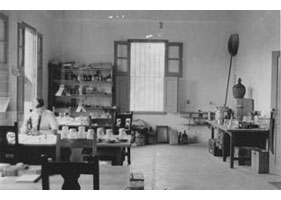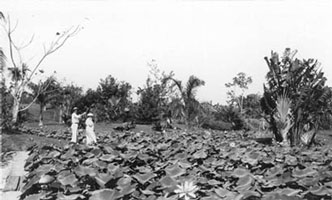The Atkins Family in Cuba: A Photograph Exhibit
The Harvard Botanical Station
E. Atkins & Co., like many sugarcane planters, was continually plagued by diseased and degenerative crops. In 1899, Harvard professors George L. Goodale and Oakes Ames visited Atkins at his Soledad plantation in Cuba. They urged him to collaborate with Harvard University to fund research into tropical biology, particularly in the hybridization of sugarcane, to improve and develop new varieties of the crop. To this end, in 1901 Atkins employed noted horticulturist Robert M. Grey to begin work on what soon became the Harvard Botanical Station for Tropical Research and Sugar Cane Investigation on Atkins's Limones plantation. Grey also built an impressive garden on the grounds, filled with tropical plants and fruit trees from around the world. In 1924, the Harvard Biological Laboratory was added to the Station to further research in tropical botany, under the direction of Dr. Thomas Barbour. After the Cuban revolution of 1959, Harvard relinquished control of the lands and facilities. Today, the garden is known as Cienfuegos Botanical Garden and is maintained by the government of Cuba.
E. Atkins & Co., like many sugarcane planters, was continually plagued by diseased and degenerative crops. In 1899, Harvard professors George L. Goodale and Oakes Ames visited Atkins at his Soledad plantation in Cuba. They urged him to collaborate with Harvard University to fund research into tropical biology, particularly in the hybridization of sugarcane, to improve and develop new varieties of the crop. To this end, in 1901 Atkins employed noted horticulturist Robert M. Grey to begin work on what soon became the Harvard Botanical Station for Tropical Research and Sugar Cane Investigation on Atkins's Limones plantation. Grey also built an impressive garden on the grounds, filled with tropical plants and fruit trees from around the world. In 1924, the Harvard Biological Laboratory was added to the Station to further research in tropical botany, under the direction of Dr. Thomas Barbour. After the Cuban revolution of 1959, Harvard relinquished control of the lands and facilities. Today, the garden is known as Cienfuegos Botanical Garden and is maintained by the government of Cuba.




